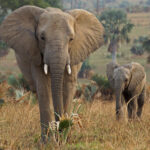The grey mangabey species of monkeys in Uganda refers to the mangabey (Lophocebus albigena), a species of Old World monkey primarily found in the dense rainforests of Uganda, particularly in areas like Kibale National Park and Semuliki national park; it’s characterized by its greyish-black fur with distinctive light grey cheeks, and is considered a relatively lesser-known primate with a threatened conservation status due to habitat loss.
The grey-cheeked mangabey lives in a variety of habitats with the forests of Central Africa; it is generally thought to live in either swamp or primary forests, in some areas it has also been found in secondary forest as well.
Uganda is known to be one of the world’s biosphere reserves, with a few endemic plants, one endemic bird species (Fox’s weaver – whose status is not clear at the moment), now the Ugandan Mangabey, which may face extinction in the near future. Our government is too slow in recognizing such natural resources that may add value to the country’s tourism potential as well as Biodiversity and ecosystems Conservation services.
Grey Cheeked Mangabey in Uganda. Welcome to our blog, where we embark on an exciting journey through the lush wilderness of Uganda to uncover the mysteries of the Grey-Cheeked Mangabey. This captivating primate species, scientifically known as Lophocebus albigena, inhabits the verdant forests of Uganda and offers a unique window into the country’s rich biodiversity. Join us as Mirama hills safaris we delve into the life, habitat, conservation efforts, and the sheer beauty of the Grey-Cheeked Mangabey in its natural home.
The Grey-Cheeked Mangabey: An Introduction: In this section, we will introduce readers to the Grey-Cheeked Mangabey, highlighting its physical characteristics, behavior, and ecological significance. Learn about its distinctive features, such as the captivating grey cheeks that lend it its name, and discover its social dynamics and remarkable adaptability to its forest habitat.
Habitat and Distribution: Uganda’s dense rainforests provide an ideal haven for the Grey-Cheeked Mangabey. Explore the geographical range of this primate species in Uganda, including the national parks most especially in Kibale forest the primate capital of the world and Semuliki national park. Discover how Uganda’s conservation efforts have helped preserve its habitat and contribute to the survival of this endangered species.
The grey- cheeked mangabeys are found in social groups containing 10-35 individuals. These groups contain several males, and most of them coexist peacefully and rarely display any type of dominance behavior. Each member within a group exhibits very expressive behavior.
The Grey-cheeked mangabey’s tail is strong enough to help it hook onto branches as it leaps through the forest. This primate’s diet is highly diverse and consists mainly of fruit, seeds, buds, nuts, leaves, shoots and flowers they also eat invertebrates such as ant larva’s, caterpillars and ants its self.
The grey-cheeked mangabey has a few predators, such as the Central African rock python, martial eagle, Nile crocodiles, leopards and crown eagles.
Gestation lasts for about 170 days and generally a single infant is born each time. At the moment of birth, a baby mangabey is almost hairless, but it already has its cherry coloured crown. Young mangabeys have darker fur than adults.
The maximum recorded age of a captive female gray-cheeked mangabey was 36 year, so in the wild we expect gray-cheeked mangabeys to live up to 18 years. Female gray-cheeked mangabeys live longer up to 26 years than males, which is common among primates.








